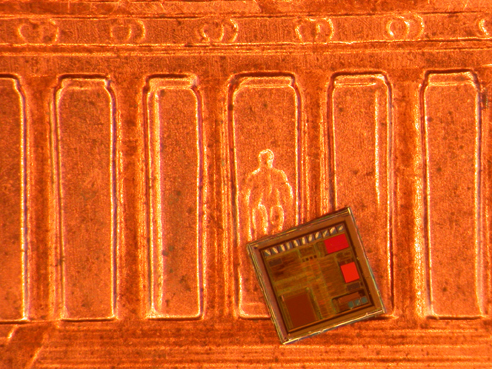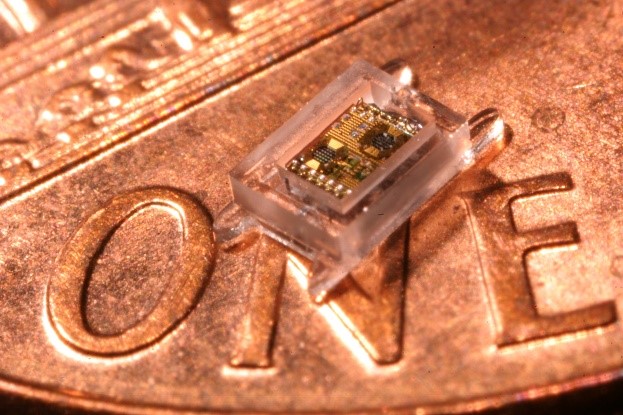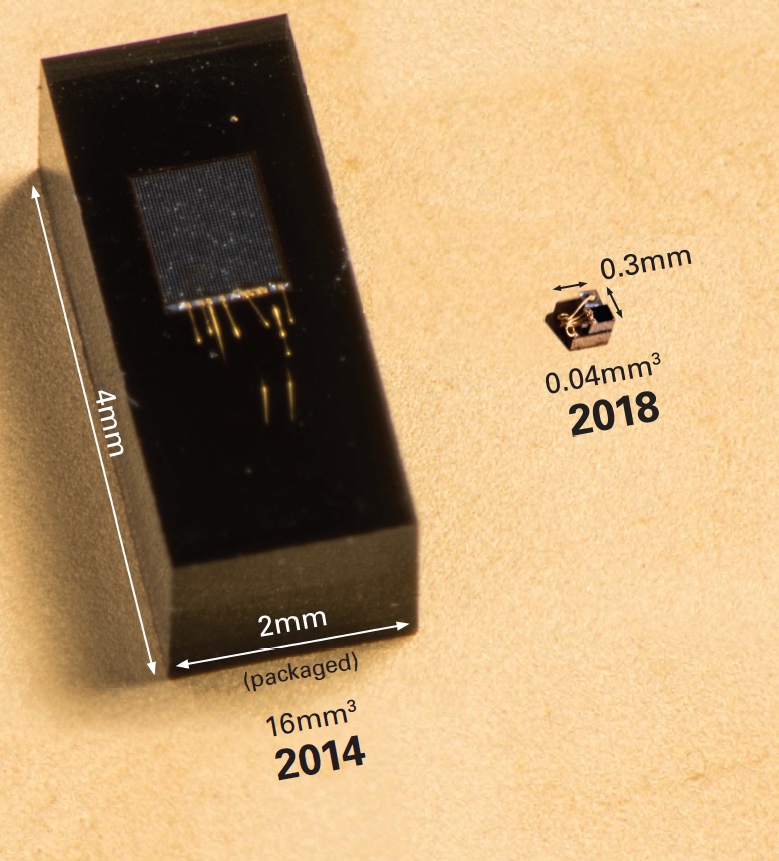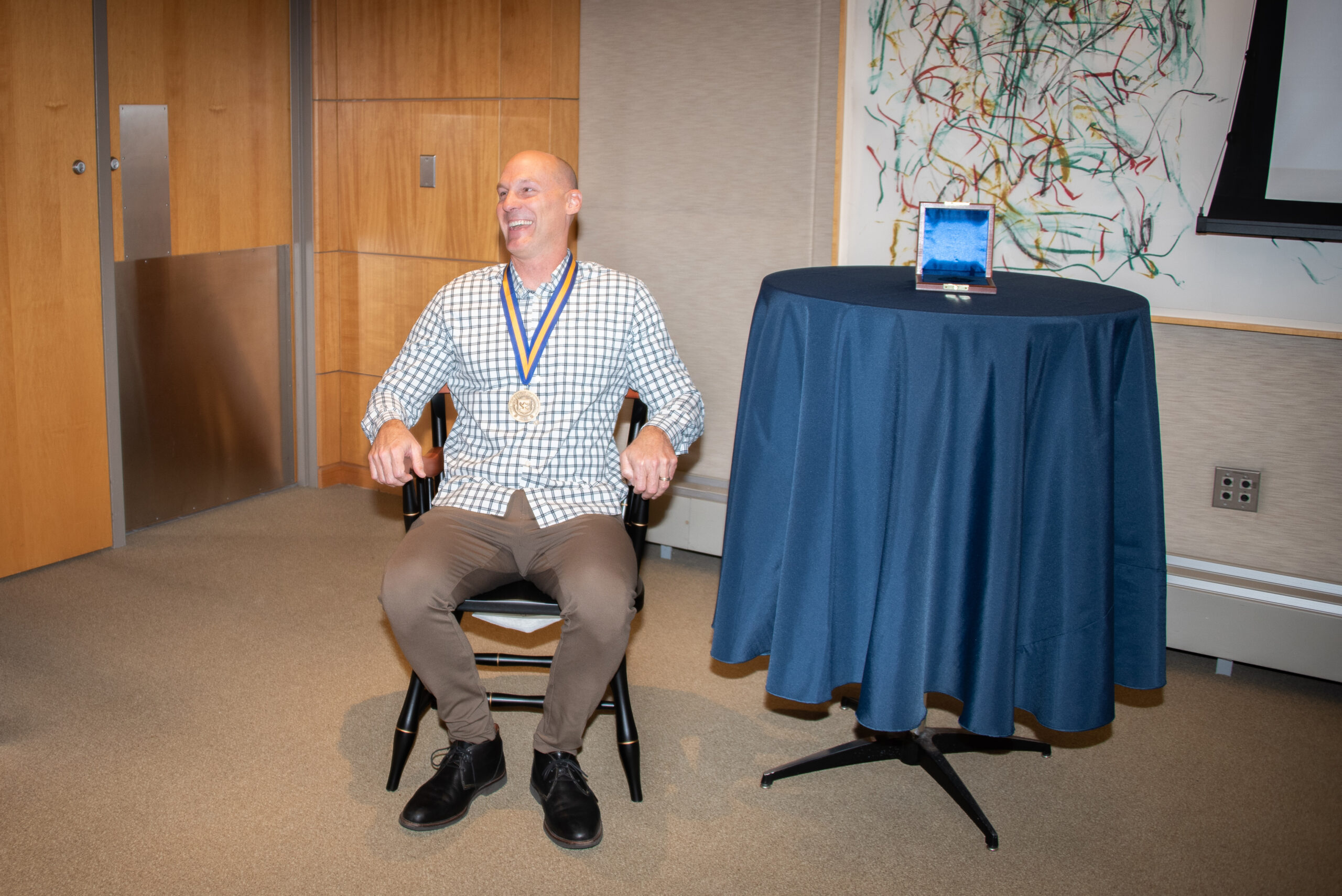Dennis Sylvester named Edward S. Davidson Collegiate Professor of Electrical and Computer Engineering
[Watch the lecture] Sylvester’s innovations in ultra-low-power computing led to the Michigan Micro Mote, the world’s smallest computer.
Dennis Sylvester was named Edward S. Davidson Collegiate Professor of Electrical and Computer Engineering in recognition of his outstanding contributions in the areas of research, education, and leadership.
Sylvester is an internationally-recognized leader in the area of ultra-low power processor design. His research and collaborations led to the development of the world’s smallest computer, called the Michigan Micro Mote (M3).
First developed for implantable medical devices, later versions of the M3 opened the door to a host of Internet of Things applications – including air and water quality detection, smart home systems, health monitoring, energy management, infrastructure monitoring, and much more.
One of the key challenges to creating a computer the size of a sugar cube is reducing power consumption so it can operate on extremely small amounts of power. Sylvester and his team were able to reduce the power consumption of these miniature sensing computers by a factor of 1000x compared to their nearest competitor. He did this by approaching the problem from a fundamentally new angle, using a technique dubbed near-threshold computing (NTC).
Introduced to the technical community in 2007, NTC lowers operating voltage to near the threshold voltage of the devices where they pivot between being on and off. The technique is applicable to high-performance, personal computing, and miniature sensor-based platforms alike. It is a technique now used by a number of the leading companies in industry.

 Enlarge
Enlarge
In 2008, Sylvester, along with David Blaauw and their research students, broke the record for processor size and low power with the Phoenix Processor. Measuring one millimeter square and consuming just 2.8 picojoules of energy per cycle, it consumed 90% less energy than the most efficient chip on the market. It was named a Key Innovation for 2008 by MIT Technology Review.
Perfecting extremely low-power computing devices enabled Sylvester and a growing team of researchers that included Prof. David Wentzloff to break through the ceiling of millimeter-scale computing in 2011 with a low-power sensor system that was 1,000 times smaller than comparable commercial devices.

 Enlarge
Enlarge
Called an intraocular pressure sensor monitor (IOPM), this device measured 1mm3 and was created to monitor eye pressure from within the eye itself. It contained a near-threshold ARM processor, a sensor (created by Professor Emeritus Kensall Wise), two solar cells, a battery, and a power management unit.
By 2014, Sylvester and colleagues were disseminating a variety of M3 computers to researchers around the world. This autonomous sensing computer included 8 stackable layers, designed so that different sensors could be inserted depending on the desired functionality, including sensing temperature, pressure, sound, and motion. It can even take pictures. Some versions of the M3 computer could transmit data as far as 100 meters.

 Enlarge
Enlarge
Just four years later, Sylvester and an expanded team of researchers that now included Profs. Jamie Phillips, Hun-Seok Kim, and Anthony Grbic developed a computing system measuring 0.04mm3. These miniscule computing devices are complete with RAM, photovoltaics, processors, and wireless transmitters and receivers. Too small to have conventional radio antennae, they receive and transmit data with visible light, which required inventing new approaches to circuit design.
Sylvester is known to be a consummate team player. In addition to his work with long-time collaborator David Blaauw, he was a member of three teams that earned the College of Engineering Ted Kennedy Family Team Excellence Award. The first was for his development of IC design techniques that led to orders of magnitude reductions in power consumption, and helped establish Michigan as a leader in low-power computing. The second was for his contributions to a major effort in microelectromechanical systems and integrated microsystems that helped establish Michigan as a leader in this area. And the third and most recent was for his contributions to the Center for Objective Microelectronics and Biomimetic Advanced Technology (COMBAT), which developed innovative solutions and new capabilities for autonomous robots.
Sylvester co-founded two companies related to low-power computing and millimeter-scale computers, and his former student founded a third.
Ambiq Micro, which provides ultra-low power semiconductor designs for battery-operated devices, IoT, wearables, and voice-controlled products, was co-founded in 2010 with Blaauw and his former student Dr. Scott Hanson. The company has grown to more than 75 employees, and has already shipped nearly 40 million chips. CubeWorks, Inc. produces the world’s smallest active wireless sensing platform. It was founded in 2013 by Sylvester, Blaauw, David Wentzloff, Prabal Dutta, Yoonmyung Lee, and ZhiYoong Foo. And former student Dr. Dave Fick is co-founder and CTO of 2012 startup company Mythic, a company based on licensed technology from Sylvester and Blaauw’s research group. Mythic builds chips for artificial intelligence in edge applications, and has already raised more than $85M in funding.
Sylvester has already published ~50 U.S. patents. Several of these patented innovations have been licensed by ARM Ltd, a global semiconductor and software design company which has shipped more than 50M units based on his research.
In recognition of his leadership as an entrepreneur and tech innovator, Sylvester received the Semiconductor Research Corporation Inventor Recognition Award in 2005, the College of Engineering Innovation Excellence Award in 2014, and the University of Michigan Distinguished University Innovator Award in 2019.
A prolific author, Sylvester has received several awards from both the ACM/IEEE Design Automation Conference and the IEEE International Solid-State Circuits Conference (ISSCC) related to his publication record and for his collaboration. Several papers received best paper awards, including his 2018 paper on neural cache which was selected as an IEEE Micro Top Picks; this award recognizes the previous year’s most significant research papers in computer architecture based on novelty and potential for long-term impact. He received the 2000 Beatrice Winner Award at ISSCC.
A leader in both academia and the professional community, Sylvester currently serves as the Senior Associate Chair for Electrical and Computer Engineering, and is a member of the IEEE Solid-State Circuits Society Administration Committee. He has served as General Chair or principal organizer of numerous professional workshops and conferences, and he helped define the circuit and physical design roadmap as a member of the International Technology Roadmap for Semiconductors (ITRS) U.S. Design Technology Working Group from 2001 to 2003.
Sylvester has taught five different courses in the areas of digital integrated circuits and VLSI Design, both at the undergraduate and graduate level. He developed two of those courses, and co-authored the book Statistical Analysis and Optimization for VLSI: Timing and Power.
In addition to the honors already mentioned, Sylvester has received the College of Engineering Education Excellence Award, 1938E Award, and the Ruth and Joel Spira Outstanding Teaching Award, as well as the University of Michigan Faculty Recognition Award and Henry Russel Award. He received an NSF CAREER Award, a SIGDA Outstanding New Faculty Award, and is an IEEE Fellow.




Edward S. Davidson

 Enlarge
Enlarge
Professor Emeritus Edward S. Davidson is internationally respected for his contributions in the areas of computer architecture, design, and performance analysis. After a successful career in industry and academia, he was recruited to Michigan to serve as Chair of the Department of Electrical Engineering and Computer Science in 1988. He served as Director of the Center for Parallel Computing from 1994-97 and was named Associate Chair of the Computer Science and Engineering division in 1997.
His research interests include computer architecture, parallel and pipeline processing, performance modeling, intelligent caches, supercomputing, and application code assessment and tuning. With his graduate students, he developed the reservation table approach to optimum design and cyclic scheduling of pipelines, designed and implemented an 8 microprocessor symmetric multiprocessor system, and developed a variety of systematic methods for computer performance evaluation and enhancement.
He received the IEEE Computer Society’s Harry M. Goode Memorial Award in 1992, and the Taylor L. Booth Education Award in 1996. He received the Eckert-Mauchly Award in 2000, presented by the IEEE Computer Society and ACM for excellence in computer architecture. He is a Fellow of IEEE and former Chair of ACM-SIGARCH.
Davidson received his B.A. in mathematics from Harvard University in 1961, his M.S. degree in communication science from the University of Michigan in 1962, and his Ph.D. degree in electrical engineering from the University of Illinois in 1968.
 MENU
MENU 
